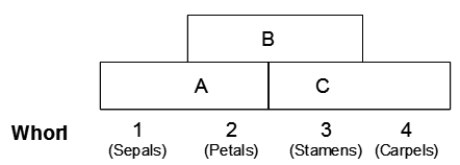Use the following to answer questions
The diagram below illustrates the normal expression of three different groups of genes (A, B, and C) within four different whorls of a developing flower. Normally, whorl 1 produces sepals, whorl 2 produces petals, whorl 3 produces stamens, and whorl 4 produces carpels. Furthermore, expression of class A genes inhibits class C genes, and expression of class C inhibits class A. 
-What kind of mutation would produce sepals in whorls 1 and 4 and petals in whorls 2 and 3?
Definitions:
Acetabulum
The socket in the pelvic bone that receives the head of the femur, forming the hip joint.
Achondroplasia
A genetic disorder characterized by dwarfism due to an abnormality in the conversion of cartilage into bone, particularly in the long bones.
Arthralgia
Pain in a joint, often not accompanied by inflammation.
Lordosis
A curvature of the spine that results in an exaggerated inward curve, typically of the lower back.
Q20: What do alkylating agents do?<br>A) They cause
Q25: Explain how DNA methylation is passed on
Q55: Which of the following statements accurately describes
Q56: Which of the following statements about response
Q60: What are their heights?<br>A) 9 cm<br>B) 54
Q61: A population consists of 100 individuals
Q66: The following nucleotide sequence is found in
Q68: You are studying the population in Iceland
Q79: Narrow-sense heritability for IQ scores has been
Q80: What is the function of DNA glycosylases?<br>A)